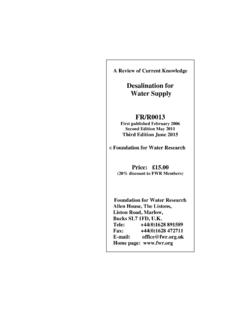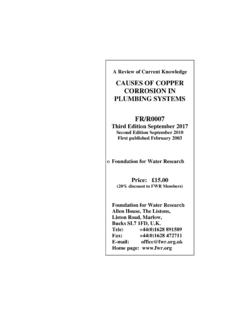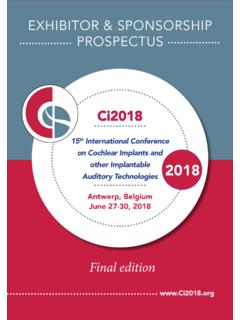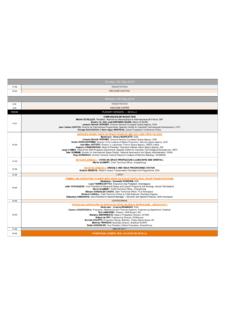Transcription of WASTEWATER RESEARCH INDUSTRY SUPPORT …
1 REPORT BY THE FOUNDATION FOR WATER RESEARCH WASTEWATER RESEARCH & INDUSTRY SUPPORT FORUM CSO SCREENS A DESIGN AND INSTALLATION REVIEW A Workshop Held Wednesday 6th July 2005 at The Visitor Centre, Cropston, Nr Leicester Evans, T. D. and Eadon, A. R. (editors) SPONSORED BY SEVERN TRENT WATER, FWR AND WAPUG Foundation for Water RESEARCH , Allen House, The Listons, Liston Road, Marlow, Bucks. SL7 1FD, UK FWR (Foundation for Water RESEARCH ) is an independent charity dedicated to education and information exchange. Its subjects are the science, engineering and management of water resources, water supply, WASTEWATER disposal and the water environment in general. FWR brings together and disseminates knowledge and makes this available widely. WaPUG ( WASTEWATER Planning Users Group) is a not-for-profit organisation established over fifteen years ago to promote best practice in the WASTEWATER INDUSTRY . Its terms of reference are to: Provide a forum for discussion between users Facilitate the exchange of information between relevant organisations Identify areas for improvement or modifications to and associated RESEARCH and development of WASTEWATER planning modules Identify education and training needs and encourage the necessary education and training.
2 First published September 2005 Any enquiries related to this report should be addressed to:- Foundation for Water RESEARCH WASTEWATER RESEARCH & INDUSTRY SUPPORT Forum Technical Secretary, Dr. T. D. Evans, Allen House, The Listons, Liston Road, Marlow, Bucks. SL7 1FD, UK Tel: +44 (0)1628 891 589 Fax: +44 (0)1628 472 711 Email: Page 4 of 56 Acknowledgements FWR and WaPUG are very grateful to Severn Trent Water Ltd. for generously hosting and supporting this workshop Page 5 of 56 1 Executive summary This workshop was instigated by WaPUG members through presentations and a preliminary forum at the WaPUG conference (Blackpool) in November 2004 (WaPUG, 2004). Combined Sewer Overflows (CSOs) are essential safety valves for the sewerage network. It is inevitable that the volume of surface water will sometimes exceed the capacity of the sewer pipes when a storm event is intense enough. It would be irresponsible to design without allowing for this possibility.
3 If a pumping station should fail, for a power outage or some other reason, or if there is a blockage the sewage will back up faster than expected in normal rainfall and defeat the practicable response time. In these situations the CSO diverts the excess volume to a least bad point of discharge: inevitably this will cause some pollution, but it is less bad than flooding people s houses, shops, places of work, etc. CSOs are thus analogous to emergency spillways on dams; these divert excess water in order to prevent the level behind the dam exceeding the designed top-water level and overtopping the dam with potentially catastrophic consequences. The potential impact is carefully assessed at the planning stage in order that there shall be minimal affect on the environment and part of this is to fit fine mesh screens to prevent the discharge of sewage debris. Within the 2000-2005 Asset Management Plan (AMP3) the water INDUSTRY has built and upgraded between 2,500 and 3,000 CSOs at a total cost of about 1 billion.
4 The outfalls from these CSOs (or the ones they replaced) had been identified by the Environment Agency as Unsatisfactory Intermittent Discharges (UID). This equates to completing one or two capital schemes valued at about 300,000 each every day of the 5 year (1,825 day) period. Remediating these UIDs involved variously increasing storage to lessen the frequency of discharge of BOD-laden (biological oxygen demand) WASTEWATER and installing screens to prevent solids > 6mm in any 2 dimensions from being discharged and causing aesthetic contamination of receiving water courses. This workshop reviewed the construction of new or upgraded CSO chambers and installation of screens within them. It benefited from open and frank discussion and a willingness to share information. Lessons have been leaned from AMP3 any areas for improvement identified. At the start of AMP3 screening CSOs was unproven technology.
5 It was not simply a matter of buying tried and tested equipment. A national testing facility was established funded by the water INDUSTRY to increase understanding of the fundamentals of screening overflows and to test manufacturers products. Two water companies established their own facilities to complement and extend the work. Screen technology has developed significantly as a result of the testing work and experience gained from completed schemes. It became apparent during the workshop that in the dash to complete the very large number of schemes many were signed off before they were finished. Sometimes suppliers were required to install screens before the construction work had been completed. Sometimes the electricity supply had not been provided so it was impossible to test powered screens. Four water companies collaborated in an independent review of 201 schemes all of which were supposed to have been completed. 34% were found to be still under the control of the contractor.
6 Only 43% of the CSO chamber-screen combinations were judged to be acceptable based on scoring against 3 performance indicators. Only 28% of the operatives present on the day of inspection were fully aware of the operation of the overflow and had received appropriate training. The suppliers had provided operating manuals but frequently they had not been passed to the operational staff. The review turned out to be more of a snagging exercise than the intended Post Project Appraisal (PPA). The workshop heard that the problems found had been remedied but would they have been had it not been for this survey? Page 6 of 56 The workshop agreed that PPA should be a routine feature of all capital projects, but that it should not be conducted until the scheme had been in operation after handover to the owner for a recommended 6 months. It was agreed that the cost of PPA should be included in the budget for each scheme.
7 Engineering is to some extent an iterative and evolutionary discipline that learns from past examples. PPA is essential to avoid repeating mistakes. The workshop heard that the standard of workmanship on the construction of CSO chambers was often very poor. As a result the chambers did not conform to their design tolerances; for example if was not exceptional for weirs to be curved, which was an obvious problem when fitting a rectilinear screen frame. It appeared that the level of supervision of construction contracts was woefully deficient. One very simple area for improvement that has been recognised would be to photographically record the condition of the screen and receiving water prior to the work; to remove residual Sewage Related Debris (SRD) from the screen as part of the project; and record the post-project conditions. The Environment Agency, which instigated the work, secures the funded improvements through consents to discharge; it is up to the discharger to comply.
8 The EA has not been afforded the resources to complete a comprehensive PPA or consent compliance assessment by inspecting all completed schemes and the receiving watercourses. The EA has assumed that the expenditure has been worthwhile and the situation has been improved because otherwise there would have been complaints from the public. Insufficient resources are being allocated/approved for proactive maintenance of sewers (routine cleaning and removal of blockages) and maintenance of CSOs. This deficiency could be alleviated by monitoring and telemetry, which is readily available and proven technology. For example monitoring can identify occasions when CSOs spill at times when rainfall has not been exceptional, or where flows are deeper than expected, both of which would be indicative of downstream restrictions to the flow and a need for investigation and cleansing. The workshop agreed that there would be considerable benefit from information sharing, knowledge management, and succession planning and training.
9 It was felt that there would be benefit to water companies from sharing their knowledge and experiences and that there is really no competitive advantage to one company being better than others in managing its CSOs. It also agreed that it would be very helpful if the water companies teams and the contractors team shared information to the benefit of the projects, and, especially for fast-learning situations, if they were co-located. This method of working is Partnering as recommended in the report entitled Rethinking Construction that was produced by the Construction Task Force, chaired by Sir John Egan, and published in July 1998; it was commissioned by the Deputy Prime Minister. The Task Force was set up to examine the scope for improving quality and efficiency in UK construction. It is very effective when the culture change required has worked through and been fully embraced by the participants.
10 Valuable lessons have been learnt from AMP3. Too many projects entailing unproven technology were committed too quickly and without due regard to good contracting practice regarding supervision. As a consequence the cost was almost certainly greater than it need have been. The cost could also have been less had sufficient resources been allowed for proactive sewer cleaning and maintenance. However there is evidence to show that surface water quality and amenity use have improved substantially. Page 7 of 56 CONTENTS 1 Executive 5 2 8 3 Workshop Conclusions .. 9 4 Recommendations .. 10 5 Background to CSOs - David Balmforth .. 12 6 AMP3 CSO Screens: Operational Experience David 15 7 Discussion session 8 A Designer s Review Remediating UIDs - Mark Shimwell .. 18 9 Post Project Appraisals Barry Thompson .. 25 10 CSO screens: a supplier s view Frank Evans, .. 28 11 CSO screens: a supplier s view Steve Skowron.
















